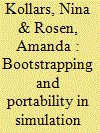|
|
|
Sort Order |
|
|
|
Items / Page
|
|
|
|
|
|
|
| Srl | Item |
| 1 |
ID:
145738


|
|
|
|
|
| Summary/Abstract |
Despite the existence of a large literature on the use and effectiveness of simulations as part of the active learning pedagogical toolbox, simulations have yet to achieve wide adoption rates among college instructors. One of the principal constraints is time: traditionally, most simulations require extensive time for the faculty to design, prepare, and use in the classroom setting. This article examines two design features of simulations aimed at solving this problem—portability, where simulations are designed as a framework that can be used for different subjects, classes, and disciplines; and bootstrapping, or the tying of the simulation content to commonly known fictional or pop-culture scenarios. Combined, these two features can reduce some of the barriers to simulation use in the classroom. We conclude by illustrating both principles with a sample simulation called “The Trial of Goldilocks.”
|
|
|
|
|
|
|
|
|
|
|
|
|
|
|
|
| 2 |
ID:
151611


|
|
|
|
|
| Summary/Abstract |
When it comes to creating new battlefield concepts and capabilities, buying cutting-edge machines is not enough.
|
|
|
|
|
|
|
|
|
|
|
|
|
|
|
|
| 3 |
ID:
136457


|
|
|
|
|
| Summary/Abstract |
In times of war, the routes to innovation are often brutally radical instead of starry-eyed and fantastical. Still, compared with all the hype and hoopla about revolutionary technologies, little scholarly ink has been spilled over these “low-end” military innovations. “Field mods,” as they are often called, are not the sexy computerized drones and robotic sensations we associate with military innovation. This article recovers the process by which one such military innovation was created and argues that the seemingly bottom-up process of Gun Truck development was in fact a dialectical outcome that emerged from two different suborganization types: a learning organization and a bureaucratic stasis model. The findings from the case carry implications for innovation theory, our understanding of the nature of military organizations in war, and the challenge of technological change in wartime.
|
|
|
|
|
|
|
|
|
|
|
|
|
|
|
|
| 4 |
ID:
136458


|
|
|
|
|
| Summary/Abstract |
In times of war, the routes to innovation are often brutally radical instead of starry-eyed and fantastical. Still, compared with all the hype and hoopla about revolutionary technologies, little scholarly ink has been spilled over these “low-end” military innovations. “Field mods,” as they are often called, are not the sexy computerized drones and robotic sensations we associate with military innovation. This article recovers the process by which one such military innovation was created and argues that the seemingly bottom-up process of Gun Truck development was in fact a dialectical outcome that emerged from two different suborganization types: a learning organization and a bureaucratic stasis model. The findings from the case carry implications for innovation theory, our understanding of the nature of military organizations in war, and the challenge of technological change in wartime.
|
|
|
|
|
|
|
|
|
|
|
|
|
|
|
|
| 5 |
ID:
146356


|
|
|
|
|
| Summary/Abstract |
On a rainy summer day in Afghanistan, Staff Sergeant Craig Cooper was returning to his operating base with his marine teammates. They were riding in the very best vehicles industry innovators have to offer: RG31 and RG33 mine-resistant armoured personnel carriers, or MRAPs. The roads surrounding their remote combat outpost were primitive, and the rain had produced treacherous conditions. As Cooper and his teammates discussed their deployment, the lead truck suddenly steered left, then stopped. Time slowed down as Cooper observed the road beneath the MRAP fall away. As Cooper and his colleagues attempted to pull the truck back onto the still crumbling road, the remainder disintegrated, causing the previously upright vehicle to flip violently onto the driver’s side. It sank rapidly into more than 150cm of water, trapping the men inside.
|
|
|
|
|
|
|
|
|
|
|
|
|
|
|
|
|
|
|
|
|